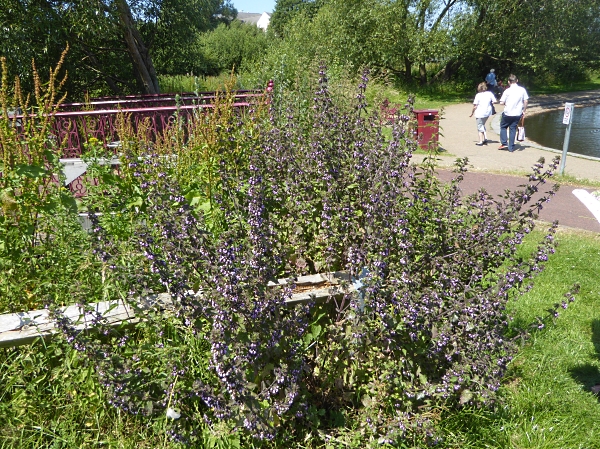We had hoped to get to Burscough for their Scarecrow Festival, but the regular bus from Ormskirk to Burscough doesn’t run on Sundays, and there were no special buses provided, so Ormskirk was as far as we got. They have some good parks, though.

Victoria Park at the junction of Ruff Lane and St Helens Road is a tiny triangular patch of trees and formal flower beds, containing an interesting monument. “To the memory of brave men who have fought for their country this column has been erected by public subscription”. It predates the First World War and it commemorates one soldier from the Crimean War and four from the Boer War. The Crimean soldier is Sgt Major James Ikin Nunnerley of the 17th Lancers “one of the six hundred” (i.e. he was in the Charge of the Light Brigade in 1854) who survived to become a local celebrity. He ran a draper’s shop in Ormskirk in later life and died in November 1905 aged 75.

Some of the trees are becoming autumnal already, with recognisable seeds. The hanging clusters of Hornbeam seeds were developing, but the Limes were still in flower. I think Ormskirk bought a job lot of Small-leaved Limes some years ago. There are no sprouting leaves at the bases of the trunks, the developing seeds appear to have little points or beaks and the creamy flowers were sticking up above the leaves. That identifies them as Small-leaved.

The monument was flanked by a Weeping Birch, and a flower bed had a pretty Sweet Gum (Liquidambar). An unassuming tree around the edge had leaves with three or five leaflets, but the seeds were clearly some kind of Acer. We couldn’t inspect the bark because there was Ivy on it, but there was another tree nearby with similar leaves, no seeds, and smooth grey bark. I think it was a Box Elder or Ash-leaved Maple, Acer negundo. They come as separate male and female trees, so the one with seeds was a female, of course, while the other must have been the male, carefully planted a few yards away as the other half of the pair. The male trees are the ones that have spectacular tassels of pink catkins in early spring. (See the one we found at Allerton Cemetery in March.)

There weren’t many birds about, just Wood Pigeons, Starlings and Blackbirds. We found a single 7-spot ladybird on some shrubs and a White-tailed Bumble Bee crawling on the grass and looking rather sick. Then we headed off to Coronation Park, spotting a tree on the way with bright red cluster of seeds. It was just a Sycamore, but one genetically endowed with a propensity to be extra-red. A pretty thing.


Many families were out in the park, where there was a funfair, and lots of extra tennis nets set out. There were no interesting birds on their pond, either, just moulting Mallards, Coots, a Moorhen and a flock of Black-headed Gulls. Beyond the drainage ditch is a wetland area / wild flower meadow, and right on the corner of the bridge was a clump of tall plants with purple flowers in whorls. Not any kind of Woundwort, and we eventually concluded it had to be Black Horehound. It differed from the book in being taller than it was supposed to be (4 or 5 feet not 3), lilac not reddish and having no detectable unpleasant smell, but the stems were square and all other features matched


The meadow was full of Meadow Sweet, Teasel and Mugwort, with occasional Tufted Vetch and Field Scabious. Only two butterflies – a Comma and a probable Small Copper. The edges were planted with young native trees – Larch, Oak and Hornbeam. I have seen one or two Rowan trees with red berries already, but the ones here had berries that were still fawny-brown.


Public transport details: Train from Central at 10.17, arriving Ormskirk at 10.48. Returned on the train from Ormskirk at 2.37, arriving Central at 3.10.
